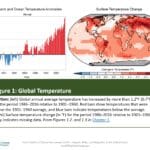Climate Impacts in Kansas Webinar Report
The Caldwell Public Library broadcasted a live webinar at noon on January 28th about Climate Change in Kansas. This internet seminar was hosted by The Climate and Energy Project with guest speaker Doug Kluck, the regional representative for National Oceanic and Atmospheric Administration (NOAA). NOAA is the agency of the United States federal government responsible for monitoring our climate and our environment, and taking steps to preserve them. Before working at NOAA, Dr. Kluck worked for the National Weather Service for 18 years and served as a research meteorologist, forecast meteorologist, forecast hydrologist and regional hydrologist.
In this seminar, Dr. Kluck discussed national climate trends, as well as local trends in temperature and precipitation. After talking about past climate trends, he discussed the most likely future climate scenarios, and he listed a variety of online resources that individuals and communities can use to get current predictions on upcoming droughts or floods, as well as tools that can help communities try to adapt to potential impacts of climate change.
The main findings from NOAA and the U.S. Global Change Research Program show that earth’s climate is now changing faster than at any other time in modern civilization, and that these changes are primarily the result of human activities. The impacts of climate change are already being felt across the country and many Americans are responding. However, neither global efforts to mitigate the causes of climate change nor regional efforts to adapt to the impacts currently approach the scales needed to avoid substantial damages.
The most likely effects that Kansans will see areincreased maximum temperatures, increased number of days over 100 degrees, increased minimum temperatures and changes in heavy precipitation events. Precipitation trends are harder to predict than temperature and there is more uncertainty in models of precipitation patterns of the future climate. However, even with normal or higher precipitation, droughts continue to be a threat because higher temperatures increase evaporation from soil.
Rising temperatures, extreme heat, drought, wildfire on rangelands, and heavy downpours are expected to increasingly disrupt agricultural productivity in the United States. Expected increases in challenges to livestock health, declines in crop yields and quality, and changes in extreme events in the United States and abroad threaten rural livelihoods, sustainable food security, and price stability. Regional economies and industries that depend on natural resources and favorable climate conditions, such as agriculture, are vulnerable to the growing impacts of climate change.
Increases in temperatures during the growing season in the Midwest are projected to be the largest contributing factor to declines in the productivity of U.S. agriculture. Projected increases in extreme heat conditions are expected to lead to further heat stress for livestock, which can result in large economic losses for producers. Climate change is also expected to lead to large-scale shifts in the availability and prices of many agricultural products across the world, with corresponding impacts on U.S. agricultural producers and the U.S. economy. These changes threaten future gains in commodity crop production and put rural livelihoods at risk. Numerous adaptation strategies are available to cope with adverse impacts of climate variability and change on agricultural production. These include altering what is produced, modifying the inputs used for production, adopting new technologies, and adjusting management strategies. However, these strategies have limits under severe climate change impacts and would require sufficient long- and short-term investment in changing practices.
Communities, governments, and businesses are working to reduce risks from and costs associated with climate change by taking action to lower greenhouse gas emissions and implement adaptation strategies. While mitigation and adaptation efforts have expanded substantially in the last four years, they do not yet approach the scale considered necessary to avoid substantial damages to the economy, environment, and human health over the coming decades.
Mr Kluck concluded with a very interesting list of resources for learning more about climate predictions, agricultural strategies, and tools for understanding and addressing climate risks in a community. The Climate Resilience Toolkit was an especially interesting way to explore how other communities are trying to build resilience for their business and communities.
* NOAA’s NCEI State of the Climate: https://www.ncdc.noaa.gov/sotc/
* NOAA’s Climate Information: climate.gov
* Regional Monthly Climate Webinar Series: https://attendee.gotowebinar.com/register/7528179497868100876
* Quarterly Climate & Drought Summaries and Outlooks: https://hprcc.unl.edu/climatesummaries.php
* High Plains Regional Climate Center: https://hprcc.unl.edu/
* Southern Plains Climate Adaptation Science Center: https://southcentralclimate.org/
* USDA Southern Plains Climate Hub: https://www.climatehubs.usda.gov/hubs/southern-plains
* Climate Resilience Toolkit: https://toolkit.climate.gov/
The Caldwell Library has a large screen available in our multipurpose community room with capability for remote learning and other uses by the public. Please contact the library if you or your organization would like to host a community learning event or activity.

